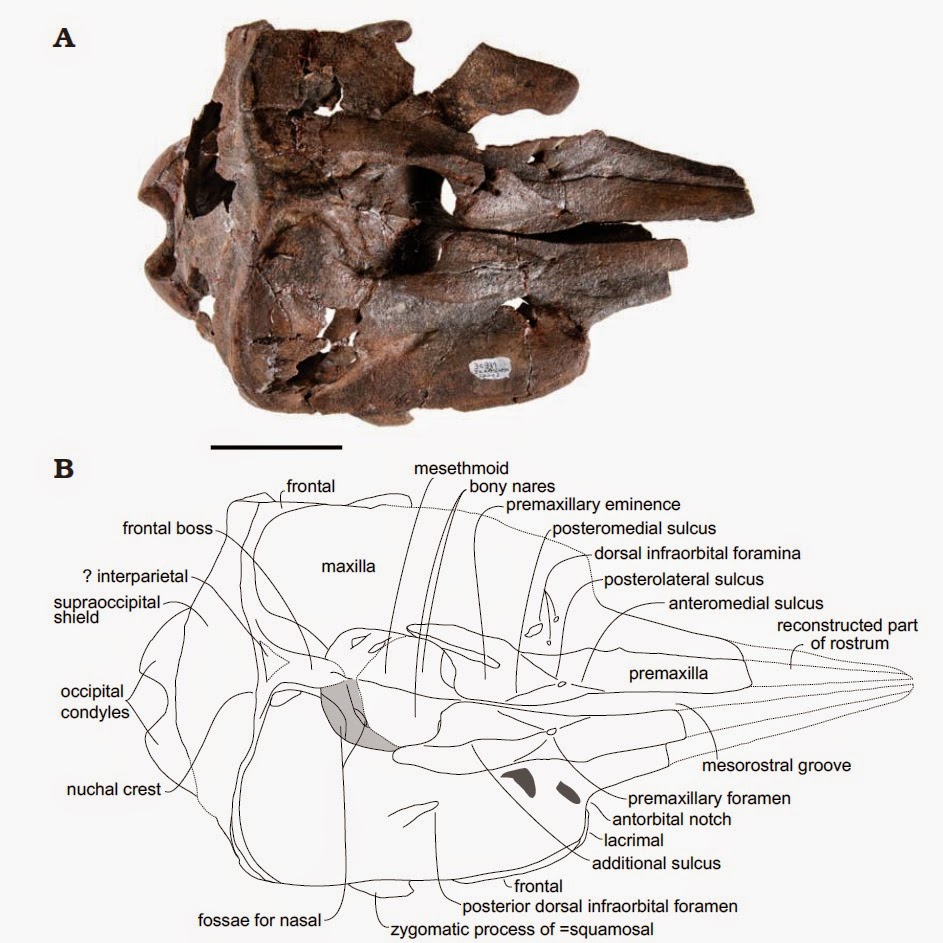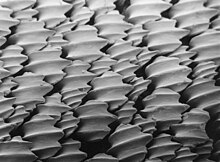Note: a shorter version of this post already appeared on the Mace Brown Museum of Natural History blog.
Porpoises belong to the modern
family Phocoenidae, and are one of the less diverse ‘families’ of modern
echolocating whales (Odontoceti), with six species in three genera. They are
all typically quite small, and have a near worldwide distribution; the harbor
porpoise itself (Phocoena phocoena) lives along most northern
hemisphere coastlines in temperate latitudes; other porpoises have a more
limited distribution, with some living in small embayments, like the critically
endangered Vaquita (Phocoena sinus). Modern phocoenids have short
snouts, and big lips for suction feeding; their teeth are quite distinctive and
are spatulate rather than conical like most other odontocetes.
A modern harbor porpoise, Phocoena phocoena (from Scholastic.com)
Porpoises have a diverse fossil
record, and extend back to the late Miocene of California and Japan; fossils
indicate they were more diverse and disparate than they are today (disparity =
ecological diversity). Phocoenids seem to be the dominant small odontocetes
from upper Miocene and Pliocene deposits of California and Japan, with few
examples of modern oceanic dolphins (Delphinidae), suggesting some significant
and rapid faunal change between the Pliocene and modern day. Today, delphinids
are the most diverse and numerically abundant small odontocetes in almost every
ocean basin. In the latest Miocene and Pliocene of the North Pacific, however,
there were delphinid-like porpoises with long snouts and approaching the size
of bottlenose dolphins, as well as smaller harbor porpoise like species; and,
of course, bizarre species like the ‘skimmer porpoise’ Semirostrum ceruttii (Racicot
et al., 2014). Certain species may have been present in both California and
Japan, in a specialized province with little communication with the North
Atlantic or south Pacific (Boessenecker, 2013).
Life restoration of the
skimmer porpoise Semirostrum ceruttii
(by R.W. Boessenecker)
The North Atlantic Pliocene
odontocete record is mostly known from fossil assemblages from North Carolina,
Belgium, and the Netherlands. These fossil assemblages are dominated by
delphinids including many modern genera. Phocoenids, however, are rare, and
known only from two specimens from the Pliocene of Belgium apparently belonging
to different genera – Septemtriocetus bosselaersi, and Brabocetus
gigaseorum (both named for the discoverers of each skull). These fossils
post-date the opening of the Bering strait, and likely represent an early
dispersal through the Arctic from the North Pacific, along with the extinct
walrus Ontocetus emmonsi. However, no fossils of phocoenids have ever
been discovered in the more richly sampled Pliocene deposits of the Atlantic
coastal plain of North America. This includes the famous Yorktown Formation at
the Lee Creek Mine in North Carolina, arguably the Pliocene marine fossil
assemblage we know the most about worldwide; no porpoises at all (Whitmore and
Kaltenbach, 2008). The Yorktown assemblage is dominated by ‘modernized’
cetaceans that inhabit the North Atlantic, whereas most of the cetaceans from
Pliocene deposits in the North Pacific belong to extinct genera, families, or
gener/families no longer inhabiting the North Pacific - again, indicating
faunal endemism different from the modern fauna.

Skull of the early Pliocene
phocoenid Brabocetus from Belgium (from Colpaert et al., 2016).
Recently, friend of the museum and
donor Ashby Gale and his fossil tour clients (Ashby runs a local business
taking visitors to publicly accessible fossil localities) discovered the first
fossil phocoenid from the Western North Atlantic (to my knowledge). It is an
isolated earbone collected from Folly Beach, South Carolina; the first was
discovered last fall, and a second specimen was just found last week and
generously donated by his client Don Pendergast. Ashby informs his clients of
the scientific significance of the specimens they find and as a result many
donations have been made to the museum (thanks!). Bedrock exposures do not
exist anywhere on the barrier island; in fact, the fossil-bearing deposit is
located offshore, and most of the fossils were accidentally dumped on the beach
as part of a beach renourishment project where seafloor sand was added to the
beach as a means to curb barrier island erosion; a slurry of seawater and sand
is pumped from the shelf to the beach by means of a large pipe. This was last
done in 2014, and it introduced a ton of fossils and large sandy limestone blocks
onto the beach; Folly Beach residents quickly became vocal about the rough debris.
Fossil collectors rejoiced, however, as fossils may now be found quite
regularly.
These two periotics are very close in anatomy to extant harbor porpoises, Phocoena phocoena, and the one shown on top (below) is close enough that I would identify it as cf. Phocoena. In particular, the anterior process is delicate and tabular, and the pars cochlearis (hemispherical prominence housing the cochlea) is large and sort of low; the posterior process is oval-shaped, unlike the broader leaf or nearly square outline of the same feature in delphinid dolphins. The second one is perhaps not as close a match for Phocoena itself, and detailed further comparisons will be needed in order to make absolutely sure this is not some kind of kentriodontid-grade dolphin, since there are exposures of the upper lower Miocene Mark's Head Formation (~18 million years old), which is a lateral equivalent of the Pungo River Limestone in North Carolina and the lower parts of the Calvert Formation (beds 2-9). Identifying delphinoid periotics is widely known to be a bit of a 'black art', and certain kentriodontids (archaic delphinoids, the common ancestors of oceanic dolphins, porpoises, the beluga and narwhal) have similar periotics to phocoenids and delphinids.
Newly collected earbones of a Phocoena-like porpoise from the Goose Creek Limestone, Folly Beach, South Carolina.
So how old are these earbones? In
particular, vertebrate fossils seem to arise from four sources. Shark teeth
appear to represent Oligocene, early Miocene, and Pliocene assemblages, with certain
extinct species reflecting each time
period. These sources are probably the Ashley Formation (early Oligocene) which
underlies most of the Charleston Embayment and produces rare Oligocene
cetaceans and teeth of the megatooth shark chronospecies Carcharocles angustidens; the second is the lower Miocene Marks Head
Formation, which produces rare sharks and marine mammals indicative of the late
early Miocene (rugose teeth of archaic dolphins, earbones of early baleen
whales like Parietobalaena, etc., the
chronospecies Carcharocles chubutensis).
The last, and most significant source, is the Pliocene Goose Creek Limestone;
this unit produces most teeth including great white sharks (Carcharodon carcharias), the famous Carcharocles megalodon, and many marine
mammals. Most dolphin earbones from Folly Beach either directly match species
from the mostly contemporaneous Yorktown Formation. Several delphinid periotics, however, are close matches for the late Pliocene-early Pleistocene dolphin Astadelphis, known only from Italy (but also recorded in an early Pleistocene bonebed in the Waccamaw Formation further inland near Charleston). A younger unit is present,
but is terrestrial and it yields abundant Pleistocene terrestrial vertebrates
(turtles, horse, armadillos, etc.); it is an unlikely source for the periotics
discovered on Folly Beach.
Ashby Gale’s discoveries are
currently being worked on by CCNHM paleontologists, and one specimen is
currently on loan to our colleague Dr. Rachel Racicot for CT scanning at
Vanderbilt University. We hope to have these interesting (albeit fragmentary)
records of porpoises published in the future!
References
F. C. Whitmore and J. A. Kaltenbach. 2008. Neogene Cetacea of the Lee Creek Phosphate Mine, North Carolina. Virginia Museum of Natural History Special Publication 14:181-269






